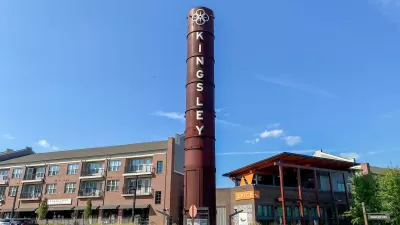Explore how cities can use financial data to enhance urban planning, improve budget allocation, and boost community services.

With financial data, urban planners make smarter decisions and support sustainable growth.
Importance of financial data for smart urban planning
Financial data allows urban planners to create more efficient cities. Take a look at why this data is essential for urban planning initiatives.
Facilitates decision-making and planning
With sound evidence based on financial data, experts can adopt strategies to make a city more efficient and convenient. For example, identifying economic hot spots where people frequently spend money can tell city planners where to invest in revitalization projects.
Improves life for residents
Are people from different counties traveling to one specific grocery store? Are they spending more money at their favorite stores, even if they’re farther away from their homes? Looking at consumer spending patterns can help city planners determine where building new stores or shopping centers might be beneficial, making life more convenient for residents.
How can city planners use financial data?
Here are some ways financial data can be used in urban planning.
1. Reduce the number of food deserts
People living in food deserts can experience health issues like diabetes, cardiovascular disease and micronutrient deficiencies. City planners can help using financial data to identify areas with limited access to fresh food.
If city planners identify areas without sufficient access to healthy food, they can focus on building grocery stores or supermarkets to help residents improve their health and their overall quality of life.
2. Identify economic hot spots
Are spending trends higher in one area of the city than the others? What types of stores and businesses already exist there? Is there a gap that a new business could fill?
Say spending patterns are higher in an area with an upscale Italian restaurant, a boutique and a bookstore. In this area, there might be the potential for a small grocery store, a coffee shop or a pharmacy.
City planners can analyze credit card, mobile pay and point-of-sale data to determine economic hot spots and make them more attractive to new businesses.
3. Optimize public transportation
Explore transit payment data to determine where there is a high need for public transportation options and identify opportunities for improvement. For example, if many people rely on buses to get to work, city planners might invest in creating more bus lines to help keep things less crowded. Working with a certified public accountant can help urban planners manage their accounting and ensure projects are economically viable and sustainable.
4. Identify thriving industries
Financial data can reveal growing industries within a city. For example, the fintech, information technology, software and health care industries are booming in Chicago.
Urban planners who identify emerging industries in their cities can attract new companies, which helps create more jobs.
5. Make payment transactions smarter
City planners focused on going digital and making their cities smarter can use financial data to determine where cash is still the primary transaction method. For example, if research finds that most people still pay for public transportation via cash, there may be an opportunity to encourage card payments.
Integrating financial data into existing urban planning tools
Explore how cities can use financial data alongside existing tools.
Geographic Information Systems (GIS)
GIS interprets geospatial data and provides information on patterns and trends. It is already used extensively in urban planning — in fact, GIS is expected to grow at a compound annual growth rate of 13.07 percent between 2024 and 2031.
GIS can help organize and manage financial data. It reveals patterns to help city planners make more informed decisions. For example, in Los Angeles, GIS software helps plan for employment and housing growth.
Data visualization software
Data visualization software converts raw data into visual elements like charts, graphs, and maps, which makes it much easier to process.
When working on urban planning initiatives, professionals can turn their data about spending habits across different zones into easily digestible graphs. They can also use maps to determine where people shop.
Financial data empowers smart and sustainable cities
Financial data can help urban planners make more informed decisions that benefit their residents and attract new businesses. They can use GIS and data visualization software to organize their data and make it easier to process.

Study: Maui’s Plan to Convert Vacation Rentals to Long-Term Housing Could Cause Nearly $1 Billion Economic Loss
The plan would reduce visitor accommodation by 25,% resulting in 1,900 jobs lost.

North Texas Transit Leaders Tout Benefits of TOD for Growing Region
At a summit focused on transit-oriented development, policymakers discussed how North Texas’ expanded light rail system can serve as a tool for economic growth.

Using Old Oil and Gas Wells for Green Energy Storage
Penn State researchers have found that repurposing abandoned oil and gas wells for geothermal-assisted compressed-air energy storage can boost efficiency, reduce environmental risks, and support clean energy and job transitions.

Santa Barbara Could Build Housing on County Land
County supervisors moved forward a proposal to build workforce housing on two county-owned parcels.

San Mateo Formally Opposes Freeway Project
The city council will send a letter to Caltrans urging the agency to reconsider a plan to expand the 101 through the city of San Mateo.

A Bronx Community Fights to Have its Voice Heard
After organizing and giving input for decades, the community around the Kingsbridge Armory might actually see it redeveloped — and they want to continue to have a say in how it goes.
Urban Design for Planners 1: Software Tools
This six-course series explores essential urban design concepts using open source software and equips planners with the tools they need to participate fully in the urban design process.
Planning for Universal Design
Learn the tools for implementing Universal Design in planning regulations.
Ascent Environmental
Borough of Carlisle
Institute for Housing and Urban Development Studies (IHS)
City of Grandview
Harvard GSD Executive Education
Toledo-Lucas County Plan Commissions
Salt Lake City
NYU Wagner Graduate School of Public Service






























